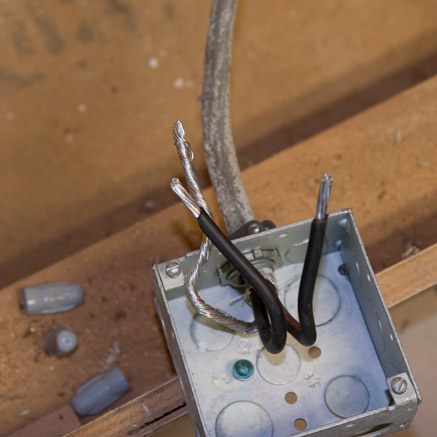

#ALUMINUM TO COPPER WIRE NUTS INSTALL#
COPALUM connectors can be costly to install and require special tools and electricians certified to use them. Surface enclosures or larger enclosures may be installed to remedy this problem. These connections are sometimes too large to install in existing enclosures. Any repairs should be done by qualified electricians familiar with aluminum wire problems and repair methods.ĬOPALUM connectors use a special crimping system that creates a cold weld between the copper and aluminum wire, and is considered a permanent, maintenance-free repair. As of April 2011, the CPSC has also approved miniature lug-type connectors called AlumiConn connectors. The more extensively tested method uses special crimp connectors called COPALUM. Consumer Product Safety Commission (CPSC) recommends one of two alternatives for a permanent repair via pigtailing. The splice of the copper pigtail to the existing aluminum wire uses special wire nuts, special crimp connectors, or special miniature lug-type connectors. “Pigtailing” involves splicing a short length of copper wire (pigtail) to the original aluminum wire, and then attaching the copper wire to the existing electrical device. Several upgrades or repairs are available for homes with pre-1974 aluminum branch circuit wiring:Ĭompletely rewiring the house with copper wires: Upgrading or repairing aluminum-wired homes:įlat 81 is waiting to be upgraded from Soviet-era aluminum cable to modern copper cable. Revised manufacturing standards for wiring devices were required. Older wiring devices not originally rated for aluminum wiring present a fire hazard. Wiring devices (outlets, switches, fans, etc.) at the time were not designed with the particular properties of aluminum wire in mind and there were problems with the properties of the wire itself. This was a hazardous situation.ĪLUMINUM WIRE REPAIR, WE PERMANENTLY REPAIR THE HAZARDS OF ALUMINUM WIRING!Ĭall us today for your aluminum wiring electrical safety inspection.In North American residential construction, aluminum wire was used to wire entire houses for a short time from the late 1960s to the late 1970s during a period of high copper prices. These splices were found outside of an approved electrical box and the surrounding insulation which was in contact also showed signs of over heating. These burned splices shown below were found in the attic in a home in the Montbello section of Denver in October of 2005. In addition to the severely burned wires and wirenuts, the box and transformer also showed significant signs of heat damage. These burned-up red and purple wirenuts at left were found at the furnace connection also at a home in the Southmoor section of Denver. The neutral wire bundle is completely fused together due to the heat damage. The damage done to the wirenuts and the amount of heat present is clearly obvious. These pictures are close ups of the burned up purple wirenuts after they were removed from the master bedroom switch. The wirenut contained 3 aluminum and 1 copper wire and operated a bath light that was working fine and not flickering.

This picture is of a switch box found in a master bedroom in the Southmoor section of Denver in July 2004 clearly shows a burned Purple Wirenut on the neutral wires. However, being that this wirenut is filled with a flammable oxide-inhibitor and the manufacturer has stated that this wirenut is NOT INTENDED FOR A COMPLETE HOME RETROFIT, ( ) we believe it is best to leave aluminum wiring alone until such a time as it can be permanently repaired via re-wiring or COPALUM crimping.Ĭlick on any image below to enlarge that image. Accordingly, from what we have seen in the field, we agree with the Commission staff and can validate the laboratory testing in believing that this method of repair does not solve the problem of overheating present in aluminum branch circuits.Īt best we consider the proper application of Purple Wirenuts a temporary repair. In CPSC-sponsored laboratory testing, some brands of twist-on connectors have performed very poorly. The Commission staff has evaluated the effectiveness of “pigtailing” as a repair. The most often suggested unacceptable repair (“pigtailing”) involves attaching a short piece of copper wire to the aluminum wire with a twist-on connector sometimes called a wire nut (IDEAL Purple #65) the copper wire is connected to the switch, wall outlet or other termination device. While these repair methods are less expensive than COPALUM crimp connectors, we agree with the CPSC that these repairs are considered unacceptable and “does not solve the problem of overheating present in aluminum branch circuits.” Burned Purple (Ideal #65) Wirenuts found in the fieldĬAUTION: Many electricians, who are not COPALUM certified, recommend other repair methods.


 0 kommentar(er)
0 kommentar(er)
